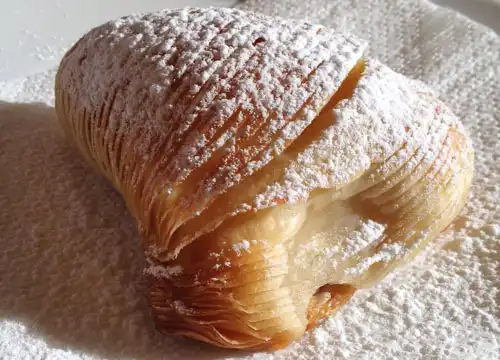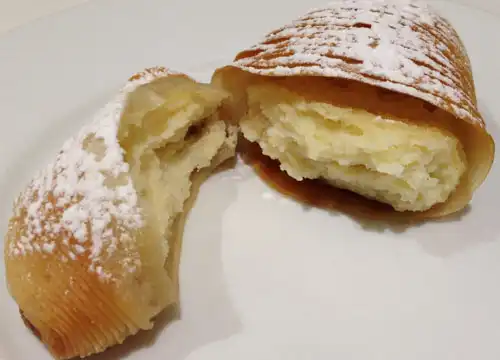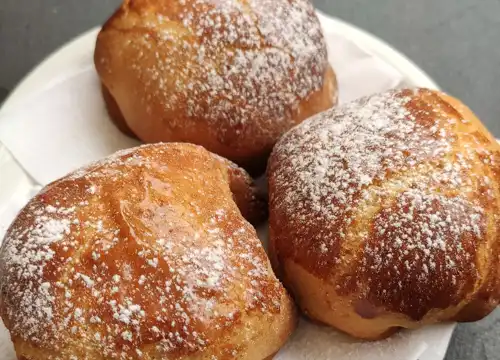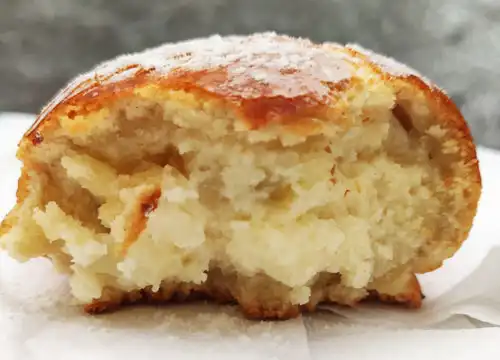Published:
Author: Antonio Maria Guerra
Sfogliatella
HISTORY, INFO, PLACES, INTERESTING FACTS

There is no doubt that Sfogliatella is rightfully part of the Neapolitan confectionary Olympus, along with other renowned delights such as Babà, Struffoli, and Pastiera. Despite its apparent simplicity, this pastry can release a unique flavor thanks to the perfect combination of just a few ingredients. Let’s find out how the specialty was born, its places, and many curiosities. Enjoy the reading!

What is Sfogliatella?
Sfogliatella (in dialect ‘a sfugliatèlla) is one of the most typical specialties of the Neapolitan confectionery tradition. It’s available in two main variants: sfogliatella ‘riccia’ (‘curly’), consisting of a crispy, triangular-shaped puff pastry shell, and ‘frolla’ (‘short’), which, as its name suggests, is made of shortcrust pastry and has a rounded shape.
It’s important to stress that both ‘riccia’ and ‘frolla’ are enriched with the same filling, made of semolina, ricotta cheese, eggs, sugar, candied fruit and natural flavorings.
Naples: the home of Sfogliatella.
Naples, the capital of the Campania Region, can boast ancient origins dating back to the 8th century, the time of Magna Graecia. It is currently one of Italy’s most sought-after tourist destinations.


The history of the Neapolitan Sfogliatella.
Although sfogliatella can be by all means considered a Neapolitan sweet specialty, it’s important to remember that its origins should be located a few dozen kilometers from the ‘city of the sun’, between the small towns of Furore and Ravello, in the famous Amalfi Coast. In this area stood a cloistered convent overlooking the sea: the convent of Santa Rosa (currently used as a luxury hotel).
According to legend, sometime during the XVII Century, a nun (who may have been called Clotilde), in order not to waste some leftover semolina, bathed it in milk, adding some ricotta cheese, dried fruit, sugar, and a little liqueur (some say it was a famous local product: limoncello). This mixture proved so delicious to be used as a filling for puff pastry: the name ‘Santa Rosa’ was given to the new dessert.
The specialty appealed quite a lot to the locals, becoming a fair source of income for the nuns. Quite inevitably, as time passed, its fame started to spread. A Neapolitan innkeeper, Pasquale Pintauro, first understood the commercial potential of Santa Rosa, but instead of copying it, he slightly revised the recipe: the result was the Neapolitan sfogliatella as we know it today. The newly appointed pastry chef devoted himself heart and soul to his enterprise, turning his tavern into a proper pastry shop. Something interesting: this pastry shop, located in the central Via Toledo, is still in business today.
Read more
It’s important to point out that the dessert modified by Mr. Pintauro corresponds to the type of sfogliatella currently known as ‘riccia’: this consists of a cone of crisp pastry enclosing a soft filling (*1) made with ricotta cheese, semolina, sugar, eggs, candied fruit and natural flavours.
It seems that the invention of the ‘frolla’ variant, characterized by the same filling but with a rounded shortbread shell, is later. Nowadays, although there are many theories, it’s not possible to determine who came up with it.
Recently there has been a rapid growth of tourism in Naples: this has led, among other things, to the development of many other variations of sfogliatella, both sweet and savory.

Where to eat the original specialty?
Here follows a brief list of some of the most traditional Neapolitan pastry shops, places where you can enjoy the original Sfogliatella.
Read more
> Pasticceria Pintauro
Address: Via Toledo, 275, Naples (Italy)
Tel.: +39 348 778 1645
> Antico Forno F.lli Attanasio
Address: Vico Ferrovia, 1-4, Naples (Italy)
Tel.: +39 081 285675
> Antica Pasticceria Carraturo
Address: Via Casanova, 97, Naples (Italy)
Tel.: +39 081 5545364
> Gran Caffè Gambrinus
Address: Via Chiaia, 1, Naples (Italy)
Tel.: +39 081 417582
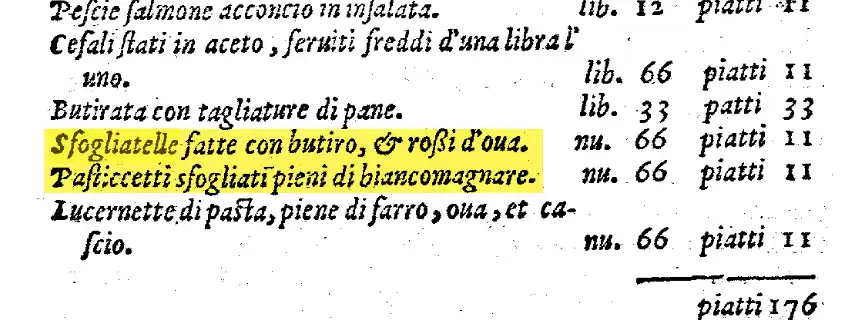
Sfogliatelle, heirs to a very ancient tradition.
The Neapolitan sfogliatella is nothing more than the evolution of another dessert, known as ‘Santa Rosa’. Although many people take it for granted that the latter is, in turn, the result of a nun’s inventiveness,
Read more
it should be stressed that the holy woman didn’t not create the recipe from scratch, but was certainly inspired by a tradition of specialties made with puff pastry dating back to a distant past.
Particularly interesting, from this point of view, is the ‘Opera di M. Bartolomeo Scappi, cuoco secreto di Papa Pio V’, written in the 16th century by the man who became famous as ‘the cook of the popes’. In his work, the author makes clear reference to “sfogliatelle fatte con butiro e rossi d’ova” (“sfogliatelle made with butter and egg yolks”) and to “pasticcetti sfogliati, pieni di biancomangiare” (“puff pastries, stuffed with biancomangiare”).

Neapolitan sfogliatella: ingredients.
The secret of the success of the Neapolitan sfogliatella lies in its simplicity: a few high-quality ingredients create a combination of flavors that anyone who tastes it cannot forget. It’s important to keep in mind that while sfogliatella ‘riccia’ has a crunchy puff pastry shell, that of the ‘frolla’ is made with shortcrust pastry. They both share the same type of filling.
Dough (sfogliatella ‘riccia’)
- Flour (best if manitoba);
- Lard;
- Sugar;
- Salt;
Dough (sfogliatella ‘frolla’)
- Flour;
- Eggs;
- Butter;
- Sugar;
- Salt;
Filling (both the types):
- Ricotta cheese (made with cow’s milk);
- Semolina;
- Egg yolks;
- Candied fruit;
- Sugar;
- Natural flavors;

The preparation of the sfogliatella on video.
In this video, recorded in the laboratory of the famous pastry shop of F.lli Attanasio, the preparation of Sfogliatella ‘riccia’ and ‘frolla’ is shown: from the filling of the dough to its baking (many thanks to the authors of the video).

Sfogliatella: calories.
The amount of calories contained in a Sfogliatella varies according to its weight. One hundred grams of the specialty contain, on average:
- Sfogliatella ‘riccia’: 290/310 Kcals.
- Sfogliatella ‘frolla’: 300/310 Kcals.
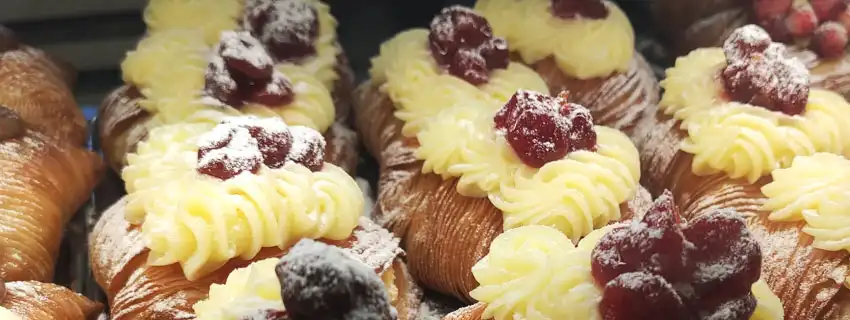
The ‘Santa Rosa’ fogliatella and the Neapolitan sfogliatella.
‘Santa Rosa’, the delicious dessert from the Amalfi Coast, can be considered the ‘mother’ of Neapolitan sfogliatella, that is, in fact, its evolution. Over time, the Santa Rosa itself has been enriched from the original recipe (including semolina, milk, ricotta cheese, candied fruit, sugar and natural flavours), by adding custard and black cherries in syrup in the topping.
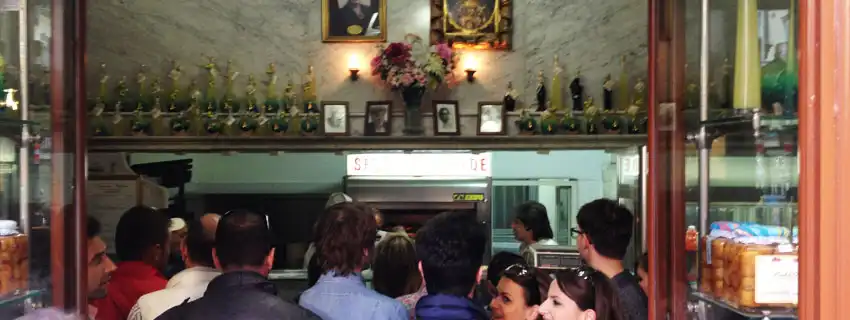
Pintauro's pastry shop.
It’s surprising to find out that, two centuries after its opening, the pastry shop founded by the inventor of sfogliatella, Mr. Pasquale Pintauro, is still in business. The shop, which is rightfully part of the historical memory of the city, is located at Via Toledo 275, the street where every true Neapolitan loves to stroll (the so-called ‘struscio’).

Sfogliatella, the best pairings.
What drink to accompany a sfogliatella? One of the best choices could certainly fall on a passito wine with good acidity. For example, an exquisite Passito di Pantelleria.
Copyright information.
The images displayed in this page belong to WebFoodCulture.

